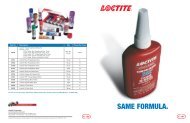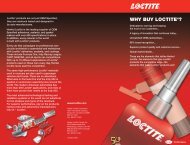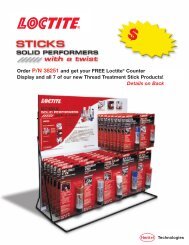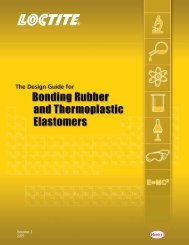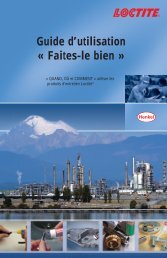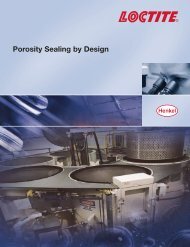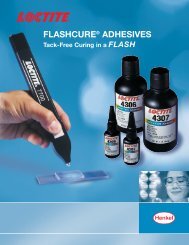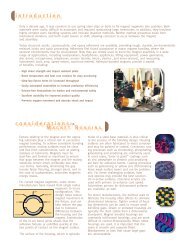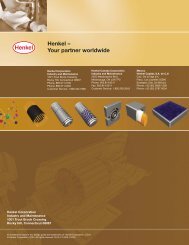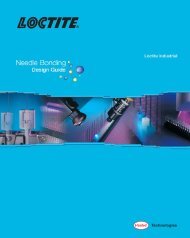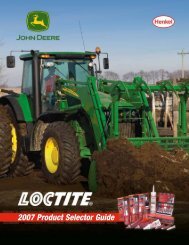Vinyl EsterThermosetTrade Names• Acpol• Corezyn• Corrolite• Derakane• Hetron• Nupol• PolycorManufacturerCook CompositesInterplastic CorporationReichhold ChemicalDow ChemicalAshland Chemical CompanyCook CompositesIndustrial DielectricsGeneral DescriptionVinyl esters are unsaturated esters of epoxy resins which are usuallyglass filled to increase their rigidity and decrease their mold shrinkage.Such fiber reinforced plastics (FRP) are usually formed by curing thevinyl ester in layers with variously configured sheets of glass. The glasssheets typically used are surfacing veils, chopped strands, choppedstrand mats, woven rovings, biaxial mats, continuous strands,unidirectional mats and/or a combination of these. Other specialtygrades available include UV absorbing, pigmented, and flame retardantgrades. In 2004, the price of vinyl esters ranged approximately from$1.50 to $2.00 per pound at truckload quantities.General PropertiesVinyl esters are known for their outstanding resistance to corrosionand a wide range of chemicals. Vinyl esters also have high impactstrengths, good elongations (3 to 10%), and high weight to strengthratios (SG = 1.1 to 1.3). The properties of vinyl ester resins areextremely versatile, and properties can be tailored to specificapplications by modifying the base resin and the composite glass fiberstructure. For example, by adding an elastomer to the bis<strong>ph</strong>enol Abackbone, the tensile elongation, impact resistance, and abrasionresistance of vinyl esters are greatly increased. The addition of anepoxy novolac resin to its backbone results in superior oxidation, heat,and solvent resistance. The ignition resistance of vinyl esters is greatlyimproved by adding bromated resins to the polymer’s backbone and/orby adding antimony oxide. Unfilled vinyl esters are slow burning andhave low smoke emission. Vinyl esters are excellent electrical andthermal insulators and have outstanding resistance to thermal aging.Vinyl esters are chemically resistant to a wide variety of chemicals,including acids, alkalis, halogenated organics, caustics, and solvents.Typical Properties of Vinyl EsterAmerican EngineeringProcessing Temperature 250°F to 300°F 121°C to 149°CLinear Mold Shrinkage 0.0005 to 0.0010 in./in. 0.0005 to 0.0010 cm/cmMelting Point – –Density 64.3 to 71.2 lb./ft. 3 1.03 to 1.14 g/cm 3Tensile Strength, Yield 9.1 to 12.6 lb./in. 2 x 10 3 6.4 to 8.9 kg/cm 2 x 10 2Tensile Strength, Break 9.9 to 12.1 lb./in. 2 x 10 3 7.0 to 8.5 kg/cm 2 x 10 2Elongation, Break 3.4 to 5.5% 3.4 to 5.5%Tensile Modulus 4.4 to 5.2 lb./in. 2 x 10 5 3.1 to 3.7 kg/cm 2 x 10 4Flexural Strength, Yield 16.0 to 21.9 lb./in. 2 x 10 3 11.2 to 15.4 kg/cm 2 x 10 2Flexural Modulus 4.4 to 5.7 lb./in. 2 x 10 5 3.1 to 4.0 kg/cm 2 x 10 4Compressive Strength 16.5 to 42.0 lb./in. 2 x 10 3 11.6 to 29.5 kg/cm 2 x 10 2Izod Notched, R.T. 0.4 to 0.6 ft.-lb./in. 2.2 to 3.2 kg cm/cmHardness M110 - M115 Rockwell M110 - M115 RockwellThermal Conductivity – –Linear ThermalExpansionDeflection Temperature@ 264 psiDeflection Temperature@ 66 psiContinuousService Temperature1.8 to 2.1 in./in.-°F x 10 -5 3.2 to 3.8 cm/cm-°C x10 -5SI200°F to 248°F 93°C to 220°C– –– –Dielectric Strength 400 to 470 V/10 -3 in. 1.6 to 1.8 V/mm x 10 4Dielectric Constant@ 1 MHzDissipation Factor@ 1 MHzWater Absorption,24 hr.2.8 to 3.5 2.8 to 3.50.002 to 0.020 0.002 to 0.0200.10 to 0.30% 0.10 to 0.30%Typical Applications• Chemical – Adsorption towers, process vessels,storage equipment tanks piping, hood scrubbers• Miscellaneous – Sheet molding compounds,electrical equipment, flooring, fans72The <strong>Loctite</strong> ® Design Guide for Bonding Plastics, <strong>Volume</strong> 4
ADHESIVE SHEAR STRENGTH(psi)(MPa)Vinyl EsterDEREKANE 411-45Vinyl Ester Resin withC-Glass Veil, 15 rmscourtesy of Dow Chemical411-45 ROUGHENEDVinyl Ester Resin withC-Glass Veil, 27 rmsDEREKANE 470-36High Temperature /Corrosion Resistant Gradewith C-Glass VeilC-695 BLACK 22920 to 30% Glass FiberMineral Filled courtesy ofAmerican Cyanamid<strong>Loctite</strong> ® 380 Black Max ® Instant Adhesive,Rubber Toughened9506.6195013.55503.8>1650 >11.4 <strong>Loctite</strong> ® 401 Prism ® Instant Adhesive,Surface InsensitiveMEDICAL: <strong>Loctite</strong> ® 4011 Prism ®Instant Adhesive, Surface Insensitive190013.1190013.1>2200 >2100 >15.2 >14.5 <strong>Loctite</strong> ® 401 Prism ®<strong>Loctite</strong> ® 770 Prism ® PrimerMEDICAL: <strong>Loctite</strong> ® 4011 Prism ® /<strong>Loctite</strong> ® 7701 Prism ® Primer8005.58005.56504.57505.2<strong>Loctite</strong> ® 414 Super Bonder ®Instant Adhesive, General Purpose195013.5195013.5>2450 >1850 >16.9 >12.8 <strong>Loctite</strong> ® 330 Depend ® Adhesive,Two-Part No-Mix Acrylic4002.810006.93502.46004.1<strong>Loctite</strong> ® 3105 Light Cure Adhesive,MEDICAL: <strong>Loctite</strong> ® 3311 Light Cure Adhesive195013.5195013.5150010.3175012.1Derekane 411-350M courtesy of Dow Chemical Company<strong>Loctite</strong> ® 3340 Light Cure Adhesive,UV Cationic Epoxy<strong>Loctite</strong> ® 4305 Flashcure ® Light Cure AdhesiveFLUORESCENT: <strong>Loctite</strong> ® 4307 Flashcure ®Light Cure Adhesive<strong>Loctite</strong> ® H3000 Speedbonder Structural Adhesive, General Purpose<strong>Loctite</strong> ® H4500 Speedbonder Structural Adhesive, Metal Bonder<strong>Loctite</strong> ® 3030 Adhesive, Polyolefin Bonder<strong>Loctite</strong> ® E-00CL Hysol ® Epoxy Adhesive,Low Odor<strong>Loctite</strong> ® E-90FL Hysol ® Epoxy Adhesive,Flexible<strong>Loctite</strong> ® E-30CL Hysol ® Epoxy Adhesive,Glass BonderMEDICAL: <strong>Loctite</strong> ® M-31CL Hysol ®Epoxy Adhesive, Glass Bonder<strong>Loctite</strong> ® E-20HP Hysol ® Epoxy Adhesive,Fast SettingMEDICAL: <strong>Loctite</strong> ® M-21HP Hysol ®Epoxy Adhesive, Fast Setting<strong>Loctite</strong> ® E-214HP Hysol ® Epoxy Adhesive,High Strength5003.5>2850 >19.7 145010.013009.0215014.87505.2>1150 >7.9 >2150 >14.8 >2300 >15.9 10006.9Adhesive Performance<strong>Loctite</strong> ® 4305 Flashcure ® Light Cure Adhesive, <strong>Loctite</strong> ® E-90FL , E-30CL and E-20HP Hysol ®Epoxy Adhesives, <strong>Loctite</strong> ® U-05FL Hysol ® Urethane Adhesive, <strong>Loctite</strong> ® 3631 Hysol ® Hot MeltAdhesive, and <strong>Loctite</strong> ® Fixmaster ® High Performance Epoxy all achieved bond strengths which weregreater than the grade of vinyl ester tested. The overall bondability of vinyl ester is good to excellent.The exceptions are the <strong>Loctite</strong> ® 3651 , 7804 , and 1942 Hysol ® Hot Melt Adhesives and <strong>Loctite</strong> ®5900 ® Flange Sealant.Surface TreatmentsSurface roughening caused either no effect or a statistically significant increase in the bondstrengths achieved on vinyl ester. The use of <strong>Loctite</strong> ® 7701 Prism ® Primer, in conjunction with<strong>Loctite</strong> ® 401 Prism ® Instant Adhesive, or <strong>Loctite</strong> ® 4011 Prism ® Medical Device Instant Adhesivewith <strong>Loctite</strong> ® 7701 Prism ® Primer, caused a statistically significant decrease in the bondability of allthe grades of vinyl ester which were evaluated.Other Important Information• Vinyl ester is compatible with all <strong>Loctite</strong> ® brand adhesives, sealants,primers, and activators.• Surface cleaners: isopropyl alcohol, <strong>Loctite</strong> ® ODC-Free Cleaner & Degreaser.<strong>Loctite</strong> ® Fixmaster ® High Performance Epoxy>2600 >17.9 <strong>Loctite</strong> ® 1942 Hysol ® Hot Melt Adhesive,EVA Based1000.7<strong>Loctite</strong> ® 3651 Hysol ® Hot Melt Adhesive,Polyolefin500.3<strong>Loctite</strong> ® 7804 Hysol ® Hot Melt Adhesive2001.4<strong>Loctite</strong> ® 3631 Hysol ® Hot Melt Adhesive,Urethane>2800 >19.3 <strong>Loctite</strong> ® U-05FL Hysol ® Urethane Adhesive,High Strength<strong>Loctite</strong> ® Fixmaster ® Rapid Rubber RepairOEM: <strong>Loctite</strong> ® U-04FL Hysol ®Urethane Adhesive, Fast Setting<strong>Loctite</strong> ® 5900 ® Flange Sealant,Heavy Body RTV Silicone>1200 >8.3 >1050 >7.2 2001.4NOTES: The force applied to the tests specimens exceededthe strength of the material resulting in substratefailure before the actual bond strength achieved by theadhesive could be determined.NOTES:The addition of the indicated additive (or surfaceroughening) caused a statistically significant increasein the bond strength within 95% confidence limits.The <strong>Loctite</strong> ® Design Guide for Bonding Plastics, <strong>Volume</strong> 4 73



